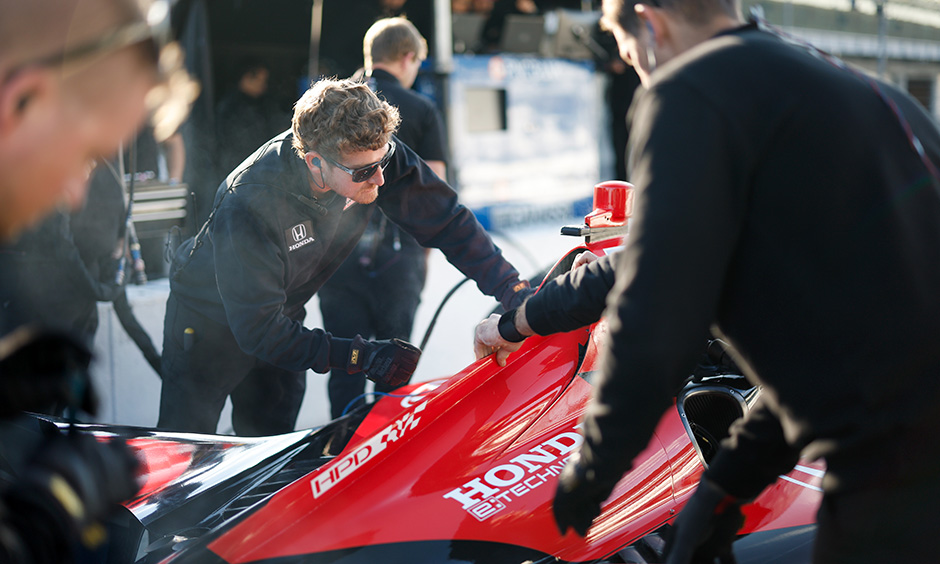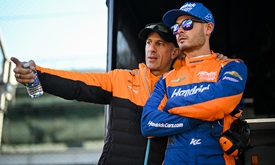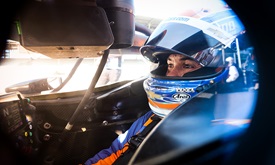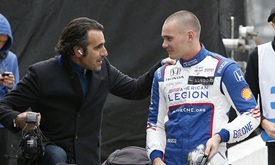Drivers Going Back to School To Learn New Hybrid System
OCT 13, 2023
Six NTT INDYCAR SERIES drivers lapped Indianapolis Motor Speedway’s historic oval this week in development of the sport’s latest technology.
An innovative hybrid system will be used with the series’ engines for the first time in the 2024 season, and the Indianapolis-based series and its competitors, including engine manufacturers Honda and Chevrolet, are learning its capabilities. The time spent at IMS followed similar test days on road courses and a short oval, plus street course simulation, and more tests are planned.
The hybrid system features an energy storage mechanism and an electric motor located inside the car’s bell housing, where the transmission connects to the 2.2-liter, twin-turbocharged V-6 engine. Tied to the drivetrain of the vehicle, the process of harvesting and deploying energy can either be done automatically or manually depending on how the series structures the rules.
In next year’s Indianapolis 500 presented by Gainbridge, it’s expected drivers will literally have the system in their hands via the paddles on their steering wheels. A pulled paddle will harvest the energy, a button will deploy it. How and when those actions occur on the track will depend on their desires.
Drivers like 2018 “500” winner Will Power of Team Penske expect to harvest energy while in the draft of another car, then dissipate the energy to generate additional horsepower to overtake that car.
“Maybe you’ll deploy and (realize) you’re not going to get them and switch it back to (regeneration) in their draft and wait for a better run,” Chevrolet driver Power said. “I think you’ll try to keep that tank full (all the) time. Instead of hitting the limiter or lifting, you’ll grab the paddle to (regenerate). It will be a constantly changing thing.
“It's now part of the game, another tool that you’ve got to be good at, and you’ve got to be smart with how you use it.”
Drivers have compared the additional surge to what they feel on road courses and street circuits when the current push-to-pass mechanism is deployed. The actual boost might not be evident to the naked eye, but its use could generate even more action. In the recently completed season, the NTT INDYCAR SERIES saw a record number of passes: 7,753 over 17 races.
Consider, too, that regenerating the system outside of a draft can momentarily slow a car – “Like you’re dragging a little bit of brake,” Andretti Global’s Colton Herta said – which also can create a passing opportunity.
“We’re still finding the most efficient way to use it and where to use it,” Honda driver Herta said. “Ideally in the race you would use it to create gaps going into the corner so you’re not entering right in front of somebody. It can change the balance of the race car, too, depending on how much (regeneration) there is. So, there’s a lot of ways it can change the race.”
INDYCAR President Jay Frye is eager to see the hybrid system in action when the season opens March 10 with the Firestone Grand Prix of St. Petersburg presented by RP Funding, a race held annually on a street circuit.
“Drivers will have a tool that they can use differently, and that will be something that will separate (them),” he said.
New Andretti Global driver Marcus Ericsson, who won the “500” in 2022 with Chip Ganassi Racing, likes the thought of having an extra ability to showcase his skill.
“I’m hoping it’s going to be a way where, as a driver, you can be smarter than your competitor and do it better than your competitor,” he said. “That, for me, excites me with a whole system that it seems is going to be quite manual, and that, I think, will be really cool.”
Also testing this week were recently crowned series champion Alex Palou of Chip Ganassi Racing and Arrow McLaren drivers Alexander Rossi and David Malukas. All six drivers combined to turn 1,325 laps (3,312.5 miles) during the two days.
Overseeing the action were officials from Honda and Chevrolet, whom Frye praised for working together in this “massive undertaking” through regular meetings.
“It’s great collaboration the way these two have worked together on this project,” Frye said. “(INDYCAR officials have) been working on this for some time. We got it to a certain point, and then we looked to our two current partners to finish the thing off and make it raceable. That’s what’s happening.”
Frye called the implementation of the hybrid system “quite a packaging marvel,” with a safe, low-voltage way of providing additional horsepower to cars at all NTT INDYCAR SERIES events.
Matt Niles, Honda’s hybrid project leader, said an aspect of development centers on making components survive in this high-speed environment where vibration is fierce.
“Also, the temperatures that we deal with, so we’ve been learning a lot about that,” Niles said. “But I think going forward, a lot of (the planning) is how we use the system and the parts and pieces. How that’s regulated on the track, how the drivers use it, how the engineers interface with it, how we go racing.”
Said Rob Buckner, Chevrolet’s INDYCAR program director: “It’s just a massive learning curve every time we go testing. It’s a new knob to turn. Race cars are really just giant energy balancing equations, and this is just another new factor in that. We found it can change car balance, and the drivers have enjoyed having a different experience in the car beyond what 2.2-liter package has been engine-wise.
“We’ll just keep learning and go from there.”



















